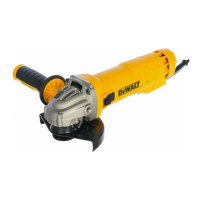12
English
of the rotating accessory and run the power
tool at maximum no-load speed for one minute.
Damaged accessories will normally break apart
during this testtime.
OPERATION
Instructions for Use
WARNING: Always observe the safety
instructions and applicableregulations.
WARNING: To reduce the risk
of serious personal injury, turn
tool off and disconnect tool from
power source before making any
adjustments or removing/installing
attachments or accessories. Before
reconnecting the tool, depress and
release the trigger switch to ensure that
the tool isoff.
WARNING:
• Ensure all materials to be ground or cut
are secured inplace.
• Secure and support the workpiece.
Use clamps or a vice to hold and
support the workpiece to a stable
platform. It is important to clamp and
support the workpiece securely to
prevent movement of the workpiece
and loss of control. Movement of the
workpiece or loss of control may create
a hazard and cause personalinjury.
• Support panels or any oversized
workpiece to minimize the risk
of wheel pinching and kickback.
Large workpieces tend to sag under
their own weight. Supports must be
placed under the workpiece near the
line of cut and near the edge of the
workpiece on both sides of thewheel.
• Always wear regular working gloves
while operating thistool.
• The gear becomes very hot duringuse.
• Apply only a gentle pressure to the tool.
Do not exert side pressure on thedisc.
• Always install the guard and
appropriate disc or wheel. Do not use
excessively worn disc or wheel.
• Be sure the inner and outer flange are
mountedcorrectly.
• Make sure the disc or wheel rotates
in the direction of the arrows on the
accessory and thetool.
• Avoid overloading. Should the tool
become hot, let it run a few minutes
1. Thread the wheel on the spindle byhand.
2. Depress spindle lock button and use a wrench
on the hub of the wire wheel or brush to tighten
thewheel.
3. To remove the wheel, reverse the
aboveprocedure.
NOTICE: Failure to properly seat the
wheel hub before turning the tool on may
result in damage to tool orwheel.
Fitting and Removing a
Backing Pad/Sanding Sheet (fig. 1, 6)
1. Place the tool on a table or flat surface, with the
guard facingup.
2. Remove the backing flange(D).
3. Place the rubber backing pad correctly onto the
spindle(B).
4. Place the sanding sheet on the rubber
backingpad.
5. While depressing spindle lock (A), thread clamp
nut (R) on spindle, piloting the raised hub on the
clamp nut into the centre of san ding disc and
backingpad.
6. Tighten the threaded clamp nut(R) with the hex
key provided or a two pinspanner.
7. Release the spindlelock.
8. To remove the rubber backing pad, loosen
the threaded clamp nut(R) with the hex key
provided or a two pin spanner.
Fitting a Wire Cup Brush
Screw the wire cup brush directly onto the spindle
without the use of the spacer and threadedflange.
Prior to Operation
• Install the guard and appropriate disc or wheel.
Do not use excessively worn discs orwheels.
• Be sure the inner and outer flange are mounted
correctly. Follow the instructions given in the
Grinding and Cutting AccessoryChart.
• Make sure the disc or wheel rotates in the
direction of the arrows on the accessory and
thetool.
• Do not use a damaged accessory. Before each
use inspect the accessory such as abrasive
wheels for chips and cracks, backing pad
for cracks, tear or excess wear, wire brush
for loose or cracked wires. If power tool or
accessory is dropped, inspect for damage
or install an undamaged accessory. After
inspecting and installing an accessory, position
yourself and bystanders away from the plane

